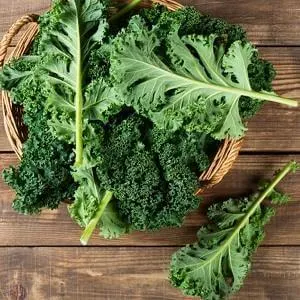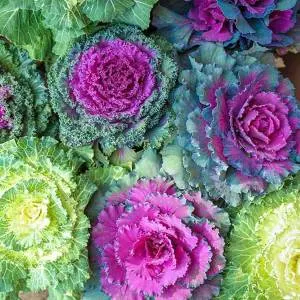 What is the best kale for juicing? Juicing is a great way to get all the health benefits of kale without dealing with its texture. Kale can be quite tough to eat, and the texture can put people off.
What is the best kale for juicing? Juicing is a great way to get all the health benefits of kale without dealing with its texture. Kale can be quite tough to eat, and the texture can put people off.
Kale has lots of vitamins and minerals, making it something of a superfood. By making juice out of this dark green leafy vegetable, you can reap the rewards while avoiding any unpleasant side effects that some people experience when they eat it.
We will talk about some varieties that are best for juicing and how to choose which one is best for your needs. Read on to find out which type of kale is best for you.
Read More: Best Blender for Kale Smoothies: 3 Powerful Models
What is Kale?
Kale is a vegetable that is a part of the cabbage family. It has large, dark green leaves and it tastes slightly bitter when raw. Kale can be cooked as well – by steaming or sauteing – but its health benefits are best realized when consumed in juice form.
There are many different types of kale that you can find at the grocery store or farmer’s market, and I will give an overview of the most popular ones below.
What is the Best Kale for Juicing?
There are over ten different varieties of kale, and five of the most popular types are Curly, Lacinto (Tuscan or Dinosaur), Red Russian, Ornamental, and Siberian. Each type has its own unique flavor profile, texture, and health benefits so it’s important to choose the best one for your specific needs.
Curly Leaf Kale
Curly leaf kale is also known as curly green kale. It turns a bright shade of green when cooked because heat releases chlorophyll which gives an intense color boost to dishes like salads and soups.
Curly leaf kale is tough with very fibrous stalks that are hard to chew through but it can be juiced without too much effort if you use this method: tear off the leaves from the stems then roll them up tightly into balls before placing between both hands on top of each other before pushing down to create flat ribbons.
Lacinto Kale
Lacinto kale is also known as Tuscan or Dinosaur kale. It has long, dark green leaves with a bumpy texture that results in an almost plate-like appearance when raw. It’s very easy on the digestive system which makes it ideal for juicing because you can drink all of its nutrients without worrying about any negative side effects like bloating or gas.
This type of kale does not have much iron but it contains high levels of calcium making this perfect for those who are looking to increase their intake especially seniors who need more bone support after hitting middle age.
Red Russian Kale
Red Russian kale has very curly leaves that are purple on the outside and pinkish-red on the inside. It’s so pretty to look at, especially when it gets its vibrant color from cold weather.
This type of kale is easy to juice but can be a little tough to chew through so you will need to use your juicer first before chewing up by hand if desired.
Ornamental Kale
Ornamental kale is quite similar in appearance to red Russian except for one key difference – this type doesn’t have any deep colors which makes it beautiful looking without being too overwhelming.
The taste profile matches closely with red Russian because they’re both milder than other types of kales like Curly or Lacinto varieties that tend to be bitter and more fibrous.
Siberian Kale
Siberian kale has short, sturdy leaves that are dark green on the outside with purple stems. It’s very interesting-looking kale that is tender and easy to chew through.
This type of kale has been known for its anti-inflammatory effects which makes it perfect for those who have arthritis or other joint pain because juicing helps break down the hard tissues so your body can absorb all the nutrients better.
Read More: Best Greens for Smoothies: 9 Delicious & Healthy Ingredients
What Should You Look For When Buying Kale for Juicing?
 There are many varieties of kale out there, but if you want something with a milder flavor profile then Lacinto, Red Russian, Ornamental and Siberian kales should be your go-to options.
There are many varieties of kale out there, but if you want something with a milder flavor profile then Lacinto, Red Russian, Ornamental and Siberian kales should be your go-to options.
Curly leaf tends to taste much more bitter than these types when raw due to their thicker texture (but they’re easily remedied by steaming). If you’ve never juiced kale before, I would recommend starting with Curly variety first because it’s easier to introduce this type into your diet.
When buying kale for juicing always look for organic produce that has vibrant colors and no blemishes on the leaves.
You should never wash the leaves until just before using them as moisture causes decay which leads to wilting so if possible get pre-washed greens then portion out what you need right away instead of storing them in a bag or container since they tend to go bad quickly after being washed.
What are the Benefits of Juicing Kale?
Juicing is one of the best ways to get more greens into your diet because you’re taking advantage of every nutrient that these plants have to offer.
Kale is a member of the cabbage family which means it has high levels of sulfur-containing compounds called glucosinolates. These are phytonutrients with antioxidant properties so they protect cells from damage while also making sure bad guys like free radicals stay away for good.
The fiber in kale provides bulk and helps keep bowel movements regular plus it adds volume without too many calories if juiced instead of steamed. Kale juice can be very filling but only contains 20kcal per 100ml so it’s a great way to lose weight if you’re cutting down on portion sizes.
Kale juice is also high in vitamin C and A, minerals like iron, calcium, and manganese plus antioxidants that have anti-inflammatory properties so they can help with chronic conditions such as arthritis or asthma over time.
The fiber content helps your body break this stuff down for better absorption by the digestive system to maximize the benefits.
What Flavor Does Kale Juice Have?
Like most dark leafy greens, kale juice has a very earthy flavor that can be slightly bitter but not overpowering. If you’re new to juicing then it’s best to start with milder flavors before working your way up so the taste isn’t too strong or pungent for you.
If you find this type of green juice is still too much on its own, try mixing 50/50 with carrots and apples to balance things out by adding sweetness while also increasing the fiber content.
You can also mix some lemon in to help cut down on bitterness plus add cucumber as well if desired since they both have high water content and won’t change how thick or thin the juice is.
Read More: Best Vegetables to Juice: 7 Healthy & Tasty Ingredients
How do You Prepare Kale for Juicing?
If you’re using curly kale then it’s best to remove the center rib before putting them in a juicer since these are very tough and can damage blades.
The tender leaves of Lacinto, Red Russian, Ornamental, or Siberian Kales only need to be roughly torn into smaller pieces so they fit better inside a chute plus all four have thick stalks which mean there’s no reason for peeling unless you prefer having less fiber content.
You should wash whatever variety you choose under cold running water just before processing but avoid soaking because moisture makes greens lose nutrients faster plus it speeds up decay if left at room temperature too long after being washed.
What is the Best Way to Store Leftover Kale Juice?
Leftover kale juice should always be stored in an airtight container filled all the way to the top without leaving any room for oxygen to get inside since it can cause oxidation that leads to nutrient loss.
This occurs when vitamins like C and A are exposed to light or heat so keep your mixture refrigerated until you’re ready to drink it up within 24 hours of juicing.
If you don’t think you’ll finish drinking everything then portion out what’s left into ice cube trays, freeze them overnight, pop them out once they are solid then store these cubes in freezer bags where they will last up to 6 months.
How Long Does Kale Juice Last?
Kale juice is best consumed immediately after it’s made, so the answer is no more than 24 hours. Freezing can help preserve nutrients but it also destroys some of them in the process depending on how long you leave your juice cubes out at room temperature before putting them back into storage or using them for smoothies.
It’s best to make kale juice right before consuming instead of doing large batches since enzymes that are responsible for helping break down fiber start to lessen over time once they’re exposed to oxygen.
Read More: Juice It Up Evergreen Smoothie Recipe: Make It At Home
Is it OK to Drink Kale Juice Every Day?
Most people should be able to drink kale juice every day if desired because it only has 20kcal per 100ml. However, if you have a condition that requires low potassium then check with your doctor or nutritionist first since eating a lot of kale can increase your potassium levels.
In general, though, most healthy adults will benefit from having dark leafy greens like kale at least once each day.
How Much Kale Should I put in my Juicer?
Start with roughly one cup of kale leaves for every 300ml of water. Then, experiment with different amounts to find what you prefer best since everyone’s tastes are unique and some people like more pulp in their juice than others.
Also, pay attention to how much color is in the juice once things have finished processing because that can tell you whether or not there are too many greens inside the juicer which could lead to unwanted bitterness if enough gets through into your mixture.
How do you get the Most Juice out of Kale?
You should always remove the thickest stalks from kale before putting them in a juicer because these are tougher and can damage blades.
Afterward, it’s best to tear off any large leaves into smaller pieces since this helps make your mixture easier to process while also increasing juice yield at the same time.
You can also try rolling up the leaves together in a ball before inserting them into the chute since this can help force the juice out of all parts of your kale.
Best Kale for Juicing – Final Thoughts
Whether you’re juicing kale for a specific health benefit or just because it tastes good, there are plenty of varieties to choose from. Each variety has its own set of benefits and drawbacks that will depend on your needs.
To find the best kale for juicing, think about what kind of flavors you prefer and which nutrients you’d like to get more regularly in order to live healthier.
I hope this article helped answer any questions you had about choosing the best kale for juicing.
